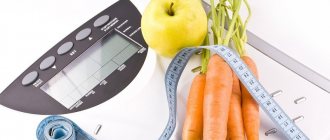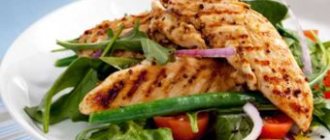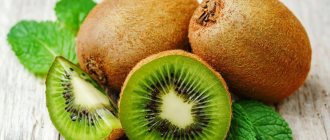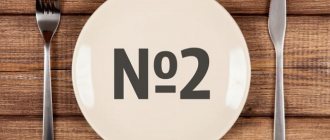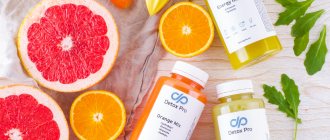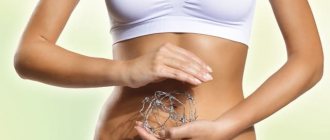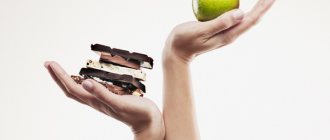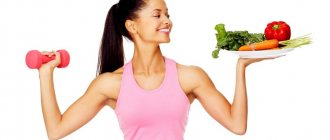Many of us remember the unique aroma of the kitchen that greeted us upon entering the kindergarten. Some people remember with horror semolina porridge for breakfast, while others are looking on the Internet for a recipe for a casserole or omelet “like in kindergarten.”
Play-Doh
Play-Doh
Meals in a preschool educational institution, children's menu, dishes and products that are included in it are one of the concerns of parents who decide to send their child to a municipal kindergarten.
The kindergarten menu in any preschool institution in our country is strictly regulated by SanPiN standards. The main requirement for the menu is that the food fully provides the growing body of the child with the nutrients necessary for the normal growth and development of the child. Creating a kindergarten menu is a real science. After all, dishes for a children's table should not only be tasty, but also healthy and provide energy for the whole day.
Principles for creating a kindergarten menu
As mentioned above, the norms and principles by which the kindergarten menu is compiled are strictly regulated.
The daily diet for preschoolers should be varied and include meat, fish, milk and dairy products, eggs, butter, vegetables and fruits, bread and cereals.
Excluding one or more food groups from a child's diet leads to children having decreased concentration and energy, and they may get sick more often and complain of digestive problems. Products are combined in such a way that dishes are not repeated within 10-20 days - the nutrition of preschoolers should not only be correct, but also varied. After all, there is nothing more boring than eating semolina porridge for breakfast every day.
Preschool cooks are not Michelin stars, and you need to understand that dishes from the restaurant menu will not be available in the kindergarten. But there will be dishes tested over the years and generations of students: porridge, casseroles, steamed cutlets, soups. In addition, when serving, age characteristics are also taken into account - for children from the nursery group, the pieces and portions will be smaller, and possible allergens, such as oranges, will be excluded from the menu.
The grocery list for the kindergarten menu is compiled in such a way that one food group can easily replace another, without loss in calorie content. For example, chicken can be replaced with turkey, some vegetables with others, etc.
It is important to note that the diet of preschool children should not contain canned food, pickled foods, wild animal meat, dairy products with vegetable fats, carbonated drinks, fried and spicy foods.
Types of infant formula
First of all, speaking about the types of infant formula, it should be borne in mind that they are produced in 3 forms: dry powder, to which you need to add water, liquid concentrate (diluted in half with water), as well as a ready-to-use liquid product that can be immediately poured into bottle.
In addition, there are two main types of infant formula based on their composition: dairy and non-dairy. The first are produced on the basis of cow's or goat's milk and are classified as adapted, that is, animal proteins are excluded from the composition of such a product, which are too difficult for an infant to digest.
Dairy-free infant formulas have been specially developed for children with intolerance to cow's milk protein or casein. They contain the same nutrients as regular adapted formulas, with the exception of whey, which is replaced by soy protein.
There are also fermented milk infant formulas that are used as a supplement to the usual adapted formula. They help prevent constipation, so they can be used as the main type of infant formula when the child has a constant problem with stool retention.
Special therapeutic and preventive infant formulas are needed in baby food for the correction and treatment of various disorders in the development of infants.
Calorie intake and age characteristics
The calorie content of meals in preschool educational institutions directly depends on age. Calorie calculation is carried out for two groups: children 1.5-3 years old, and children 4-6 years old.
If for the first age group the calorie content is 1550 kcal, then children of the older age group of preschool educational institutions should receive at least 1900 kcal per day. It is important to note that all meals in kindergarten should contain up to 30% fat, up to 15% protein and up to 55% carbohydrates in the total value of the diet. These standards were developed by the Institute of Nutrition of the Russian Academy of Medical Sciences.
Meals vary in their calorie content. Breakfast in kindergarten should account for 25% of a child's daily calorie needs, depending on his age group. Lunch and afternoon tea are 40 and 15% respectively. Therefore, if a child has dinner at home and not in kindergarten, parents should create a menu for this meal so that the child receives the remaining 20-25% of the calories he needs.
It is important to note that it is recommended to prepare dishes immediately before eating them. Food that has stood for more than two hours is considered unsuitable for children's kitchens.
According to current standards, the daily menu of a kindergarten should consist of 5 meals, and three meals should contain hot dishes, because without hot food healthy digestion and proper metabolism are impossible. Hot meals are provided to all children who spend more than 4 hours a day in a preschool institution (no matter municipal or private).
Also, according to pediatricians, a preschool child should eat every 4 hours. This important rule is also taken into account when creating menus in kindergartens. Below is the average meal schedule in preschool institutions:
- 8.30-9.00 - breakfast;
- 10.30-11.00 - second breakfast;
- 12.00-13.00 - lunch;
- 15.30-16.00 - afternoon snack;
- 17.00-17.30 - dinner.
Nutritious infant nutrition
Breast milk contains all the fats, proteins, microelements and vitamins a baby needs. And, importantly, they are fully absorbed by the child’s body. Formulas, no matter how balanced they are, are still less complete nutrition for children.
Here are the benefits of breast milk:
- Allergies to proteins contained in mother's milk practically never occur in children. In addition, they are rich in beneficial amino acids that are important for growth and development.
- Fats contain fatty acids, which are also very useful. In addition, they are better broken down thanks to lipase, which is found in breast milk. This guarantees the child normal stool, without constipation and painful colic.
- Among carbohydrates, breast milk contains lactose, which ensures normal acidity in the baby’s stomach and intestines. And this is of great importance for the life of bacteria (useful ones perform their functions, and harmful ones are suppressed). In addition, mother's milk contains enough calories for the baby's growth.
- The baby is protected from viruses and infections by immunity, the formation of which is facilitated by important hormones and biologically active components that make up breast milk.
- Breastfed children are less likely to be obese and have a lower risk of developing diabetes (in adulthood).
- Breast milk is the most complete nutrition for newborns; it is always at the right temperature, never stale, or sterile. There are no harmful bacteria in it, as there may be in artificial formulations.
- Babies who suckle at the breast develop a correct bite. In addition, it later reduces the risk of stomatitis or caries.
- Breastfeeding is also good because it forms a special emotional and psychological bond between mother and child. They are calm, the baby feels protected, the mother feels self-confident, which is important for the nervous system of both.
Legal norms and innovations
The director of the kindergarten can decide what products and dishes to feed the children, but provided that the new menu compiled meets the requirements, all documentation, and if the preschool children receive the calories necessary for their age. In addition, if desired, parents can familiarize themselves with the menu, which is compiled for at least 10 days. If questions or illegal situations arise, parents have the right to seek advice from the regional Rospotrebnadzor.
Supplies to the municipal kindergarten are carried out by the company that won the supply tender. However, each product that enters the kindergarten kitchen must have a quality certificate, all the necessary invoices and veterinary certificates.
At the moment (since January 2021), a number of changes in the organization of menus in kindergartens have come into force. There are more than 15 changes to SanPiN 2.3/2.4.3590-20, and one of the most important is that now the child can be fed food from home, and the preschool educational institution must provide a place where the food can be heated.
However, this does not mean that every preschooler can eat a burger instead of soup for lunch. This change was made mainly for children with allergies and is possible with the appropriate certificate.
Below you can see a sample weekly kindergarten menu.
Monday:
Breakfast: semolina porridge with marmalade, loaf with butter and cheese, tea with milk.
Second breakfast: peach juice.
Lunch: “Summer” salad (st. cucumber and tomato with green onions), pea soup, meatloaf with egg, pasta, cherry compote, wheat bread.
Afternoon snack: milk, waffles.
Dinner: vegetable stew, Royal salad (beets with lemon), tea with sugar, rye bread.
Tuesday:
Breakfast: “Solnyshko” corn porridge with milk, a loaf with butter, cocoa with milk.
Second breakfast: apple
Lunch: “Radish” salad of radishes and onions, pickle soup with sour cream, beef goulash, complex side dish (mashed potatoes, fried cabbage), dried apricot compote, wheat bread
Afternoon snack: bifilux (fermented milk drink), Viennese bun.
Dinner: noodle pie (casserole) with cheese, tea with lemon, rye bread.
Wednesday:
Breakfast: oatmeal porridge with milk, apple, loaf with butter and cheese, coffee drink with condensed milk.
Second breakfast: fruit.
Lunch: “Cabbage” salad (cabbage, onion), bean borscht served with sour cream, pink salmon baked with vegetables, rice, lingonberry jelly, rye bread.
Afternoon snack: tea with milk, marshmallows.
Dinner: omelet with sausage, fresh fruit compote, wheat bread.
Thursday:
Breakfast: wheat porridge, loaf with butter, cocoa with milk.
Second breakfast: juice.
Lunch: “Signor Tomato” salad, fish soup with herbs, liver beef stroganoff in sour cream sauce, buckwheat, currant compote, wheat bread.
Afternoon snack: cocoa drink, curl with jam.
Dinner: potato casserole with meat, “Cipolino” (onion) salad or “Princess and the Pea” salad (green peas), lingonberry drink, rye bread.
Friday:
Breakfast: milk noodle soup, loaf with butter and cheese, cocoa with milk.
Second breakfast: fruit.
Lunch: “Carrot” salad (boiled carrots with apple and onion), potato soup with meatballs and green peas, zucchini stuffed with meat, cranberry jelly, wheat bread.
Afternoon snack: tea with lemon, cookies.
Dinner: fish stew, Princess and the Pea salad (green peas, boiled egg), blueberry compote, rye bread.
- share with your friends!
Foods that a nursing woman should avoid
For every mother, the priority should be to provide children with a nutritious, balanced diet. Therefore, a breastfeeding woman should definitely think about what she eats.
Take your time to introduce several new products to the menu at once. The optimal pace is one product for two weeks. At the same time, be sure to monitor the baby’s reaction: whether there are any rashes or redness on the skin, whether the stool has changed, whether the mood and behavior have worsened.
We recommend
“Proper nutrition as a factor in maintaining human health” Read more
Here's what you should completely exclude from your diet
:
- alcoholic drinks;
- coffee and too strong tea;
- raw onions and garlic;
- any soy dishes;
- honey;
- any fruits, vegetables or berries of bright colors (red, orange);
- chocolate products;
- everything is hot, spicy, food with lots of seasonings;
- mushroom dishes;
- everything smoked, canned, pickled, prepared on the basis of fermentation (including kvass or sauerkraut).
- any products with dyes, preservatives or food additives;
- fruits of exotic origin, all citrus fruits;
- peanut;
- carbonated drinks.
Complete nutrition for children 1-3 years old
Basic principles of organizing nutritious nutrition for children under 3 years of age:
- The daily amount of food for a child of the second year of life is 1000-1200 ml (water is not taken into account here), for the third year of life - 1200-1500 ml. At one time, the baby should eat no more than 250-300 ml.
- There are five feedings per day. Of these, breakfast, lunch and dinner are the main ones, and two additional ones in the form of a second breakfast/afternoon snack and supplementary feeding before going to bed (a mixture or something made from fermented milk products).
- The calorie distribution is as follows: 25% for breakfast, 30-35% for lunch, 20% for dinner, 10% for second breakfast (or afternoon snack) and “milk” before going to bed.
- Give your child dairy products three times a day.
- Fruits and vegetables should be included in meals four times a day, cereal dishes (porridge, side dishes) once, and bread two or three times.
- The rate of meat consumption (including poultry) is 100 g per day (given once or twice a day). Fish (and dishes made from it) is enough about 200 g per week (given 2-3 times during the week). It is not advisable for children aged 1-3 years to include sausages, frankfurters, and small sausages on the menu. They are high in fat, spices, salt and food additives.
- Three eggs per week is enough.
- When your child is thirsty, give him plain water, no sugary drinks.
- Salt and sugar – to a minimum. Salt - no more than 3 g. And sugar is already found in various desserts, fruit purees, compote and jelly, as well as dairy and other products. The sugar limit is no more than 25-30 g.
- You can also continue breastfeeding; until you are two years old, you can breastfeed your baby once or twice a day.
- How many times to feed a day to ensure adequate nutrition for children is an individual question, but there is no need to give any sweets, juices, cookies, etc. in between main meals.
- There is no need to force your child to eat quickly or persuade him to finish eating if he shows that he no longer wants to. You should not promise something sweet in exchange for the fact that the baby eats well.
- Repeat attempts to feed the child a dish that he did not immediately want. The tenth time he tries it, he might even like it.
- A number of foods should be excluded from children's diets in the first three years of life. These are mushrooms, all kinds of canned products (both homemade and purchased), dry concentrates. You should also not give spicy foods, sauces, horseradish, mustard, vinegar, pepper and mayonnaise. Eliminate any soda, as well as products with flavors, dyes and any artificial additives. A child does not need cakes, pastries or anything that contains combined fats.

